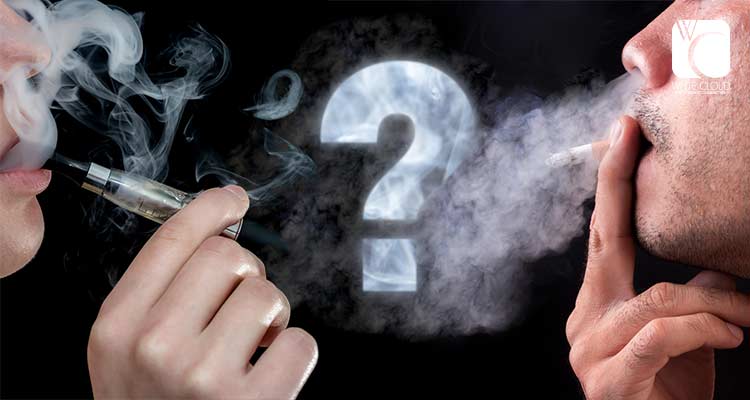Since Public Health England released an evidence-based review concluding that vaping is 95 percent safer than smoking, it’s getting harder to deny the benefits of choosing e-cigarettes over traditional tobacco. Despite politicians, public health officials and media outlets trying their best to scare people away from e-cigs, study after study has suggested that e-cigs contain only a fraction of the harmful chemicals found in tobacco cigarettes, and vaping may even be as harmless as breathing air. Let’s look back at the research over the past few years that has led us toward a growing consensus about e-cig safety.
Studies Show E-cig Vapor is Less Harmful than Tobacco Smoke, Year After Year

Harm reduction has always been a key talking point for vaping advocates. We know that tobacco is deadly, and e-cigs could be a safer alternative to smoking. Opponents, on the other hand, may rightfully argue that “safer” is a relative term and ask, “Just how safe are they, really?” Now we have adequate data to answer that question in detail.
Is E-cig Vapor Safe for Bystanders?
No one wants to choke on secondhand smoke, which we all know is dangerous, but how safe is secondhand vapor? Researchers at New York’s Roswell Park Cancer Institute set out to answer this question in 2013 when they examined vapor produced by three different brands of e-cigs. TThey found no traces of carbon monoxide, aerosol particles or any of the volatile organic compounds present in secondhand vapor. The only significant byproduct of vaping was nicotine, and nicotine levels were far lower in vapor than they are in smoke. The scientists ultimately concluded, “Using an e-cigarette in indoor environments may involuntarily expose nonusers to nicotine but not to toxic tobacco-specific combustion products.” Research has indicated that, by itself, nicotine is relatively harmless and could even have therapeutic applications, so there may be no reason to run away from vapor clouds.
What Exactly is in E-Cig Vapor?

In 2014, the journal Regulatory Toxicology and Pharmacology published the results of a study meant to quantify the harmful and potentially harmful constituents (HPHCs) released in secondhand vapor. After using a machine to create samples of cigarette smoke and e-cig vapor, investigators analyzed the contents of both to find traces of 55 HPHCs including carbon monoxide and toxic metals. The differences were staggering: The tobacco smoke housed levels of HPHCs 1,500 times higher than what was found in vapor. Five different e-cigs, three made by blu eCigs and two made by SKYCIG, were compared with two types of tobacco cigarettes, Marlboro Gold Box and Lambert & Butler, with identical results each time.
What exactly was in the e-cig vapor? The same things that are in most e-liquids: nicotine, vegetable glycerin and propylene glycol. Trace quantities of five specific HPHCs were also detected, but their presence comes with some important caveats. First of all, while researchers did detect levels of acetaldehyde, acrolein, phenol, propionaldehyde and N-nitrosoanatabine in the e-cig vapor, their concentration was 1/900 of what was measured in the smoke. Also, the same HPHCs were present in the air blanks that the researchers used as a control. Indeed, all of the air that you inhale has some HPHCs, but when compared to smoking, vaping may only be as risky as breathing regular room air.
What Does E-cig Vapor Do to Your Lungs?

Last year, Toxicology in Vitro published the results of a collaborative study between British American Tobacco and MatTek Corporation that tested the effects of e-cig vapor on living lung cells. Confirming the suspicions raised in the previous study, researchers found that e-cig vapor has the same effect on lungs as ambient air.
With the assistance of 3D modeling, scientists used epithelial cell cultures to replicate the type of tissue that makes up the human respiratory tract. After six hours of exposure to e-cig vapor via a VITROCELL system, an “inhaling” robot often used in safety testing for tobacco cigarettes, the tissue remained just as viable as an identical sample of cells that had only been exposed to air. When subjected to tobacco smoke under the same conditions for the same period of time, nearly all of the respiratory cells died.
How Much More Evidence Do We Need?
Three studies on the effects of e-cig vapor conducted three years in a row all yielded the same conclusions: When compared to tobacco cigarettes, e-cigs pose virtually no danger to vapers or bystanders. Now that we know e-cigs can be made safely, we need to maintain high industry standards to keep vapers safe and satisfied. Companies can begin by disclosing their e-liquid ingredients, which White Cloud has always made transparent. People often pick up e-cigs because they want a healthier lifestyle, so we owe it to our customers to ensure our products do not contain the same harmful chemicals as tobacco cigarettes.






